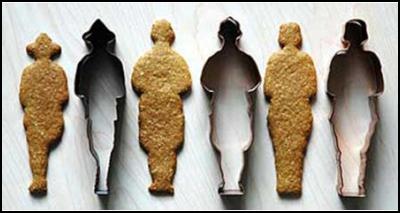Food for thought from ANZAC biscuit exhibition
Thursday, 21 March 2013, 1:12 pm
Press Release: Massey University
March 21, 2013
Food for thought from ANZAC biscuit exhibition
An art exhibition and installation of ANZAC biscuits to be staged in France offers real food for thought about the carnage and casualties of World War I.
Associate Professor Kingsley Baird from the College of Creative Arts, who is responsible for some of New Zealand’s best-known contemporary memorials, has created the artwork.
Mr Baird, who is based at the School of Art, has designed cookie cutters in the shape of able bodied and maimed soldiers from World War I.
Twelve differently shaped cookie cutters - depicting Australian, New Zealand, French and German soldiers – will be used to cut out ANZAC biscuits produced by French bakers.
The soldier-shaped biscuits will be used in an installation-performance by Mr Baird to make a three-metre long sculpture, called Tomb, at France’s leading World War I museum, the Historial de la Grande Guerre in Péronne, northern France in the three weeks preceding ANZAC Day. Upon completion of the sculpture in April more than 18,000 biscuits will have been baked for the artwork. It will then be exhibited till November.

The variety of cookie cutter shapes, depicting soldiers from four separate warring nations easily distinguishable by their headwear, is also a commentary on the shared carnage and loss wrought in Europe almost a century ago, Mr Baird says.
Advertisement - scroll to continue reading
Each biscuit shape is reminiscent of a soldier statue memorial in a town square with the four nationalities able to be easily identified by the New Zealand ‘lemon squeezer’ hat, the Australian ‘slouch’ hat, and French and German helmets.
“Mutilated –armless and legless soldiers – and their ‘complete’ compatriots comprise the Tomb sculpture, Mr Baird says. The ‘mass grave’ of ‘soldiers’ and the ephemeral nature of the memorial express the monumental waste of war.”
The choice of ANZAC biscuit with which to depict the broken bodies of war was also a natural one to make given its long association with the army corps established in World War I.
“It has been claimed they were sent by wives to soldiers abroad because the ingredients do not spoil easily and the biscuits kept well during naval transportation. However, the combination of the name ANZAC and the recipe now associated with it apparently first appeared in 1921,” Mr Baird says.
The Tomb sculpture is based on the Stone of Remembrance designed by Sir Edwin Lutyens and found in Commonwealth War Graves cemeteries. It is an expression of the ephemeral nature of memory, national identity, sacrifice and the waste of war; all key themes in Mr Baird’s longstanding research of memory and remembrance.
The exhibition coincides with research being undertaken by military historian Professor Glyn Harper who is part of Massey University’s contribution to the Centenary History of New Zealand in World War I, marking 100 years since the outbreak of the conflict.
The Centenary History will contain multiple volumes dealing with different aspects of New Zealand’s involvement in the war.
The Centenary History project will play a leading role in how New Zealanders remember World War I. It also shows the critical mass of research expertise the University has to offer in this area,” Mr Baird says. In 2004 Mr Baird designed the Tomb of the Unknown Warrior in Wellington, and three years earlier the New Zealand Memorial in Canberra with Wellington architectural firm, Studio of Pacific Architecture.
His latest work will be exhibited at a leading military museum in Dresden, Germany next year, 100 years after the outbreak of World War I.
The installation-performance Tomb is being staged at the Historial De La Grande Guerre in Péronne, Northern France from April 8-22, 2013 and the exhibition continues till November 24.
ENDS
Advertisement - scroll to continue reading
a.supporter:hover {background:#EC4438!important;} @media screen and (max-width: 480px) { #byline-block div.byline-block {padding-right:16px;}}
Using Scoop for work?
Scoop is free for personal use, but you’ll need a licence for work use. This is part of our Ethical Paywall and how we fund Scoop. Join today with plans starting from less than $3 per week, plus gain access to exclusive Pro features.
Join Pro Individual Find out more
Find more from Massey University on InfoPages.